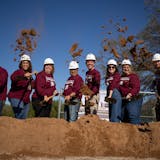On an unseasonably warm day about a week into the coronavirus shutdown, Elena Delle Donne (a star player for the Washington Mystics of the WNBA, Olympic gold medalist in basketball and avid golfer) and her wife, Amanda, were musing about how nice it would be if golf courses were open.
A short time later, Delle Donne emerged from a basement workout to find that Amanda had built an intricate mini-golf course in their Alexandria, Va., front yard.
So, naturally, Delle Donne pulled on a pair of plaid trousers, unearthed a putter and started swinging. "We had a blast," she said. "Our neighbors were jealous. They wanted to play."
From the time that most leisure activities came to a grinding halt in March, people have been seeking out new, often inventive ways to keep occupied and entertained. Enter: mini golf.
Typically associated with midcentury resort kitsch, mini golf has actually been an escapist diversion since the early 20th century.
Mini-golf courses were "one of the first places where women were allowed to socially go unaccompanied," said Maria Reidelbach, who co-wrote the 1987 illustrated history "Miniature Golf."
During the Great Depression, children would create their own courses in vacant lots. The game's popularity crested in 1930. Early Hollywood stars, Reidelbach discovered, couldn't be photographed playing, out of studios' fears that encouraging fans to partake in the so-called "madness of 1930" could eat into box office earnings.
These days, mini golf has been professionalized — each spring (except, for the obvious reasons, this one), the United States Pro Mini Golf Association hosts its own U.S. Open — but it also remains accessible for hobbyists, with courses dotted across the country. But you can make your own mini-golf course. Here's how:


